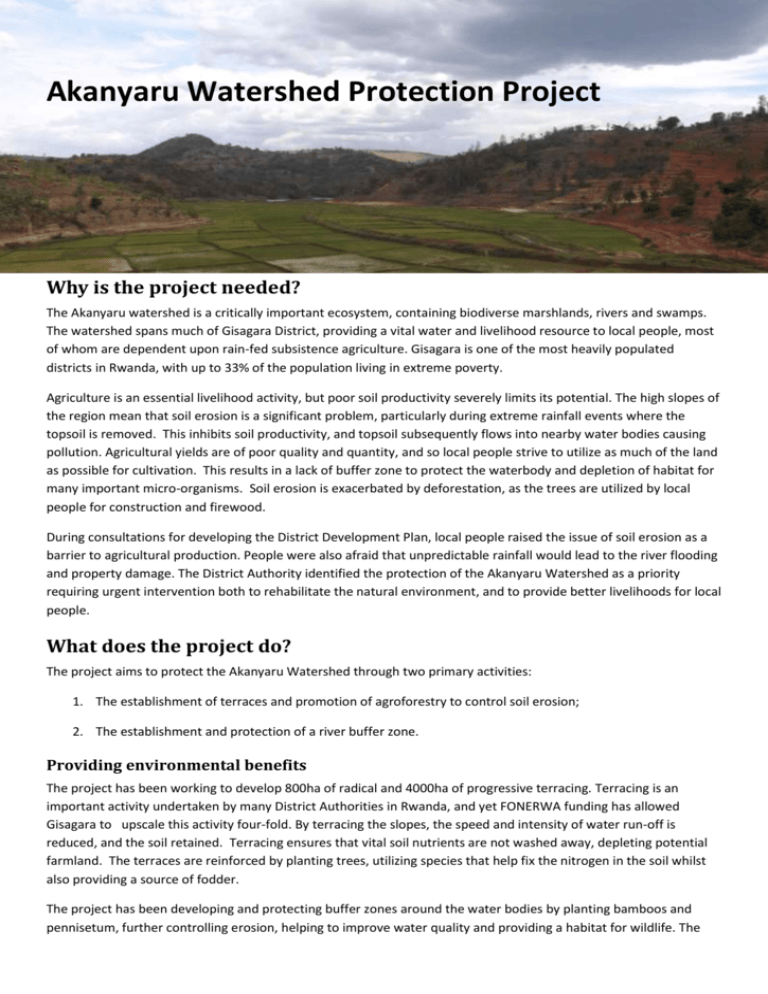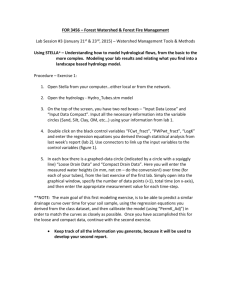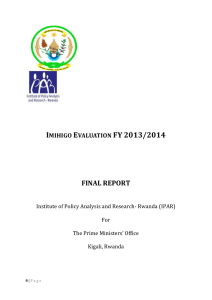Akanyaru Watershed Protection Project
advertisement

Akanyaru Watershed Protection Project Why is the project needed? The Akanyaru watershed is a critically important ecosystem, containing biodiverse marshlands, rivers and swamps. The watershed spans much of Gisagara District, providing a vital water and livelihood resource to local people, most of whom are dependent upon rain-fed subsistence agriculture. Gisagara is one of the most heavily populated districts in Rwanda, with up to 33% of the population living in extreme poverty. Agriculture is an essential livelihood activity, but poor soil productivity severely limits its potential. The high slopes of the region mean that soil erosion is a significant problem, particularly during extreme rainfall events where the topsoil is removed. This inhibits soil productivity, and topsoil subsequently flows into nearby water bodies causing pollution. Agricultural yields are of poor quality and quantity, and so local people strive to utilize as much of the land as possible for cultivation. This results in a lack of buffer zone to protect the waterbody and depletion of habitat for many important micro-organisms. Soil erosion is exacerbated by deforestation, as the trees are utilized by local people for construction and firewood. During consultations for developing the District Development Plan, local people raised the issue of soil erosion as a barrier to agricultural production. People were also afraid that unpredictable rainfall would lead to the river flooding and property damage. The District Authority identified the protection of the Akanyaru Watershed as a priority requiring urgent intervention both to rehabilitate the natural environment, and to provide better livelihoods for local people. What does the project do? The project aims to protect the Akanyaru Watershed through two primary activities: 1. The establishment of terraces and promotion of agroforestry to control soil erosion; 2. The establishment and protection of a river buffer zone. Providing environmental benefits The project has been working to develop 800ha of radical and 4000ha of progressive terracing. Terracing is an important activity undertaken by many District Authorities in Rwanda, and yet FONERWA funding has allowed Gisagara to upscale this activity four-fold. By terracing the slopes, the speed and intensity of water run-off is reduced, and the soil retained. Terracing ensures that vital soil nutrients are not washed away, depleting potential farmland. The terraces are reinforced by planting trees, utilizing species that help fix the nitrogen in the soil whilst also providing a source of fodder. The project has been developing and protecting buffer zones around the water bodies by planting bamboos and pennisetum, further controlling erosion, helping to improve water quality and providing a habitat for wildlife. The buffer zone also decreases the risk of flooding, giving farmers more security over agricultural land. Together, these activities prevent the siltation of nearby water bodies, and ensure that downstream aquatic and human life can continue to derive benefits from the river. In the longer term, it is hoped Ubudehe refers to the long-standing that the buffer zones will attract tourism to view the many bird species practice and culture of collective action that exist around the Akanyaru Watershed, itself an Important Birds Area and mutual support to solve problems (IBA). within a community in Rwanda. One of the functions of Ubudehe has been to Providing social development benefits establish poverty level categories to From the outset, the project engaged in substantial dialogue with affected enable communities and individuals to local communities to understand their needs and concerns, as local define their development priorities. ownership was recognised as critical for the long-term sustainability of the project. The project made use of local environmental committees to oversee the hiring and managing of local labourers to complete the work to develop the terraces and buffer zone, in close collaboration with the local authority. These committees prioritize individuals who are in greatest need of the opportunity, utilizing Ubudehe categories to identify beneficiaries. Imihigo means to vow to deliver. It is used as a tool to improve accountability and quicken pace in achieving development objectives. Government bodies, district authorities, communities and individuals use the concept to complete objectives, determined to overcome any arising challenges. These employment opportunities provide a windfall of income which people use to fulfil individual imihigo or “performance contracts”. Imihigo are aggregated to village and District levels, contributing to social development objectives on malnutrition, education and medical insurance. Many beneficiaries bought livestock, school equipment, or made improvements to their houses. By encouraging beneficiaries to form cooperatives and utilizing local social structures, people are encouraged to save money and invest in things that allow them to diversify their livelihoods, and use the short-term income generated in a way that has lasting benefits. In addition project beneficiaries felt that they would continue to benefit through better use of the land, and more productive agricultural practices. How does the project promote green growth? Although the project is primarily designed to protect the environment, the project implementation approach is already having a significant impact on social development in the Gisagara District. The benefits resulting from the project are a win-win for people and the environment, as the training received from the project and improved knowledge and understanding of managing natural resources is likely to ensure sustainability of project outputs and benefits. Habyiman Alphonse, standing in front of the terraces he was employed to work on. Alphonse was one among thousands of Rwandans evicted from Tanzania in 2013, forced to abandon his house, employment as a farm labourer, and members of his extended family. He returned to Kigembe in Gisagara District in 2014 with his wife and three children, where a friend was able to host him. Thanks to employment on the project, he has been able to buy school uniforms for his children and plans to use his savings to buy land so he can build his own house. Learning the skills to do terracing has given him hope of more work opportunities in future. In addition to protecting the environment and providing employment to local people, the project has a positive impact on the interactions between them, equipping people with the knowledge, skills and resources to be able to derive better livelihoods that also protect the environment. Implementing Organisation: Gisigara District Authority Gisagara District is in the Southern Province of Rwanda, and lies along the border with Burundi. The District Authority is made up of 56 staff, with three project staff contracted specifically to implement the project. The project staff are project coordinator Noel Ndayishimiye (far right), environmental technician Jean-Pierre Ngarambe (right), and district environmental facilitator Rigobert Bayingana (far left). They are joined here by Daniel, an intern from the Rwanda Environment Management Authority (REMA). Beneficiaries from the Kansi sector. These individuals represent some 1,400 members from the sector.







